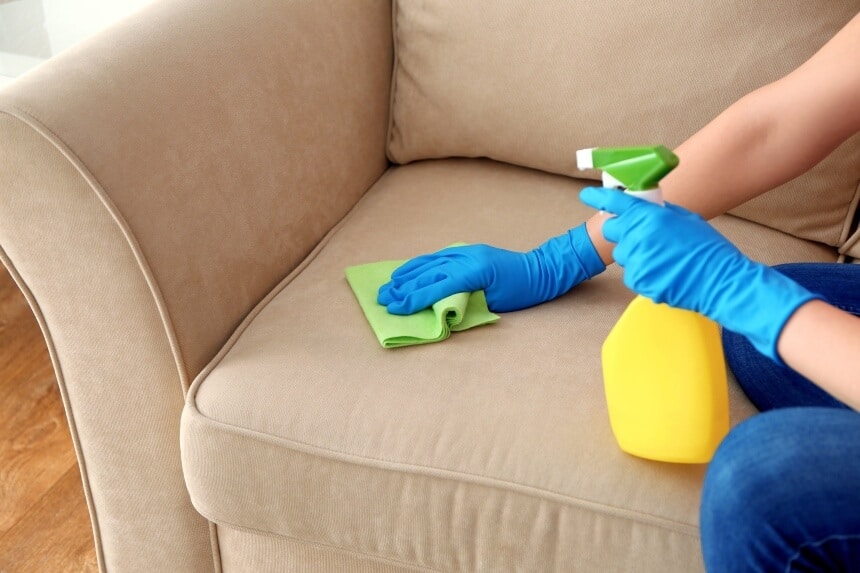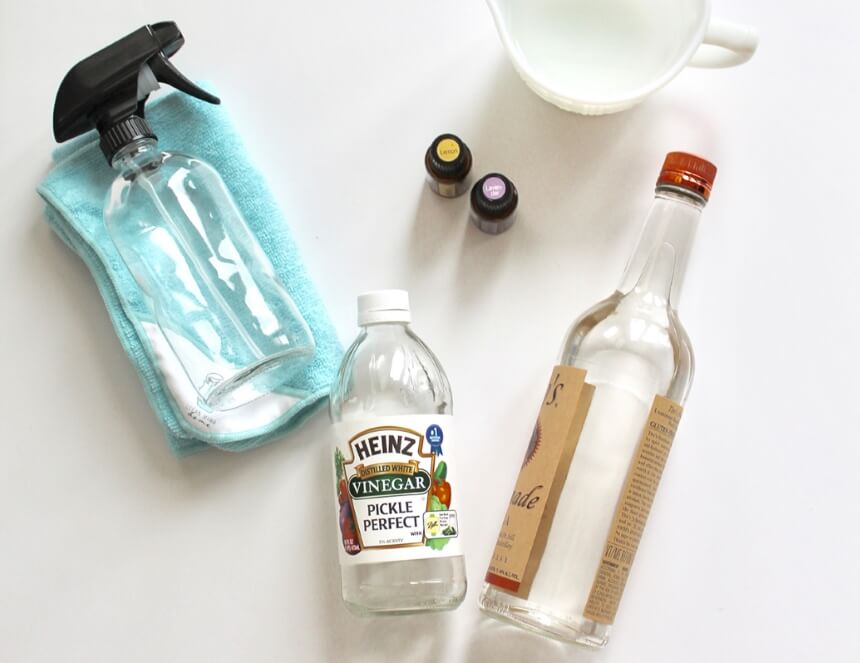Polyester is a popular synthetic fabric because it is inexpensive, sturdy, comfortable, and durable. It is also more resistant to stains and tear and wear, compared to other materials such as satin, microfiber and faux leather. However, any furniture gets dirty or stained, so you need to learn how to clean polyester fiber couches to expand their lifespan.
Majority of polyester couches only require to be rubbed with a cleaner easily available at your local store. Just like you perform a skin test prior to using a skin care product to check that it is safe, do a pre-test of the cleaner on a tiny inconspicuous area on the couch. To maintain fluffiness, remember to rub the couch afterwards with a soft-bristled brush. We have written a detailed article on how to clean polyester fiber couches because the material is so common that you will also find other materials incorporating polyester blends to make their texture fluffy and soft.
Polyester and polyester blends are generally resistant to discoloration and abrasion, making the material the go-to fabric for stain-resistant sofa beds because it is one of the easiest to clean. It is also breathable and available in a wide variety of colors to match your décor. We will discuss the best way to clean polyester couches to prevent cracks from exposure to fluctuating temperature, peeling from high pressure or loss of structural integrity from overstretching.
If you have bought your furniture from a reputable seller, then it will come with a cleaning code underneath it, in the cushions or in the creased sections. These codes guide you on the best products and cleaning practices for your fabric to maintain the color and avoid damaging the upholstery. The codes are as follows:
W indicates that you can safely clean your couch with water only, or a water-based detergent like vinegar or lemon juice, or a steam cleaner for stubborn dirt. This is the most ideal material when you have kids who constantly spill food or drinks because it is the easiest to clean.
S stands for dry-cleaning or spot-cleaning of stains with a solvent. Solvents should be used in well-ventilated rooms to avoid toxicity. They are also combustible, so use them away from any open flames.
If the tag has X symbol, it means that the fabric should only be cleaned by vacuuming it instead of using water or solvents. You may also remove stains by light brushing. This type of material is more common in blinds than couches because it may require professional cleaning.
O is for fabric that should be cleaned with cold water.
Couches with WASH tag are machine washable with cold water on delicate setting. This type of material should then be air-dried or tumble dried on low heat.
The last tag you are likely to see, although rare, is a W/S code combination. This is for versatile fabric that can be cleaned safely with a steam vacuum as well as water-based and solvent-based cleaners. As we mentioned earlier, a pre-test of every cleaner is required as a safety precaution.

Before vacuuming, some people prefer applying a thin layer of deodorizing baking powder for approximately 20 minutes because it absorbs odor by neutralizing the acids that are responsible for unpleasant smells.
Polyester couches should be cleaned once or twice a year, but one in constant use should be vacuumed regularly for proper maintenance.
The second step is to clean the couch with a cleanser that is safe and suitable for your polyester couch (check out this one from Black Diamond, for example). Your choice of cleaner will be guided by the cleaning code tag on your couch. Fortunately, polyester rarely requires professional cleaning.

It is important to allow the couch to dry completely after cleaning to prevent proliferation of mold and mildew which grow in damp conditions.
Some cleaners give polyester couches a stiff texture that can be avoided by rubbing the fabric in a circular motion with a brush with soft bristles.

Blood stains are removed by dabbing the spot with a cloth moistened with hydrogen peroxide. Once you notice bubbling, wipe off the spot with a dry cloth. Never use hot water on fresh blood stains since this will make them adhere to the surface Trusted Source Stain Removal Guide | The American Cleaning Institute (ACI) Need to remove tomato sauce, grease, ink or other tricky, hard-to-remove stains? Our stain guide will tell you how to get stains out of your clothes. www.cleaninginstitute.org of the couch.
To clean grease stains, apply a thick layer of baking soda and allow for up to one hour before brushing it off gently. Then clean it with a mild detergent. To speed up complete lifting of the grease stains, you can use borax or hydrogen peroxide.
Remove a stuck chewing gum quickly by rubbing it with an ice cube to harden it for easy lifting.
If you have kids, then you may find your polyester couch stained with ink. Most people use hairspray to remove it, but it is the alcohol in the spray that works.
If the pet urine is recent, apply white vinegar and baking soda and leave it on the stain for a while before blotting it out. For an older stain, mix baking soda with hydrogen peroxide and add a few drops of mild cleanser. Spread this mixture on the stain, reapplying a thin layer until the soiled spot is clean. The baking soda will also get rid of the odor.
Sweat stains are common but easily eliminated with a mixture of water and white vinegar.
Looking at these solutions to common stains, you can see why polyester is the preferred material for furniture. Majority of stains only require a mild cleanser and vinegar or hydrogen peroxide which are affordable and easily available. Always remember to remove stains as soon as possible and follow the recommended cleaning code for that specific fabric.
To make a polyester couch cleaner at home, all you need is 1 quart of warm water, one tablespoon of white vinegar and another tablespoon of laundry detergent. Put this mixture in a spray bottle to spritz away most stains.
You may also need to acquire baking soda, borax and hydrogen peroxide to add them to your DIY cleanser to remove stubborn stains and odor.
Now you have all the tips you need to clean your polyester fiber couch. If the stains are stubborn, and none of the tips worked, it doesn’t mean you need to throw your sofa away. Try a polyester fabric slipcover, this PAULATO BY GA.I.CO. cover, for example, is among the most popular on the market today. And no wonder: such things give your old sofa a new lease on life.





